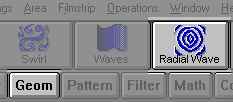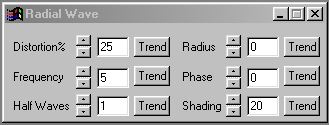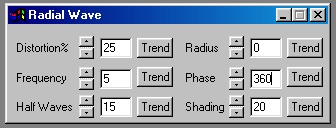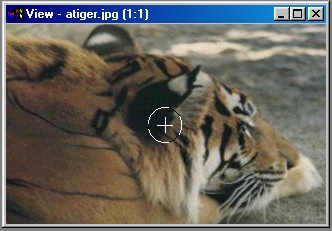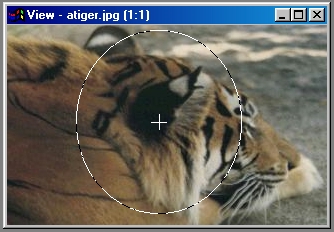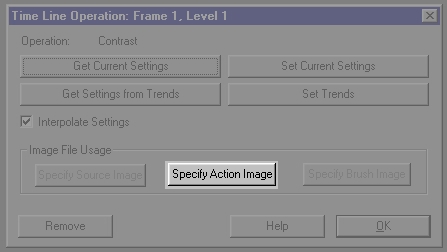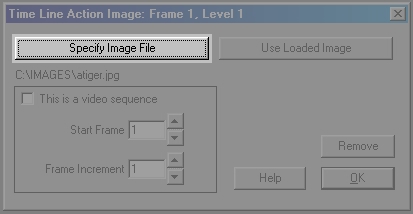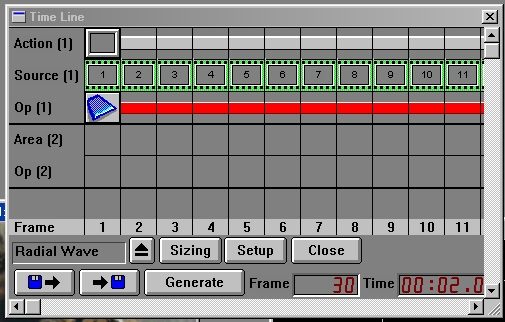| This is a child page. You can use Parent in the quick nav bar at the top or the bottom of the page to navigate directly back to the parent of this page. Some child pages are more than one level deep, and in that case will require more than one Parent click to reach the outermost document level. |
...advanced tutorial continued from previous page:
Now we will set the parameters for the Radial Wave operation. Open the radial wave dialog by clicking on its icon in the Geom group...
...once the dialog is open we will want to set the parameters to the following values: Distortion:25, Frequency:5, Half Waves:1, Radius:0, Phase:0, Shading:20. Once you have adjusted the parameters to these settings, you will be ready to place the first radial wave icon in the TimeLine. (Before you try to place the radial wave operation into the TimeLine, make sure that frame 20 is are visible.) Now, use the drag and drop method to place an icon in frame 20. If frame 30 is also visible, place another radial wave icon there. If it is not visible, scoll the TimeLine until it is visible, and then place the 2nd radial wave icon in frame 30.
If we were to generate the radial wave with these settings, there would be no movement in the wave. This is due to the fact that frame 20 and frame 30 have the exact same settings at this point, because you have made no changes. We want to create a rippling splash effect, so we will have to change the settings for frame 30. This can be done by double clicking on the radial wave operation icon in frame 30. Now, select the Set Current Settings option...
...this will access the Radial Wave dialog so that you can alter or view the key frame's current settings. You will want to change the following parameters: Half Waves:15, and Phase:360...
...these changes will result in a wave which starts at the center of the area selection, and then radiates outward over the remaining ten frames. Click on the TimeLine dialog to confirm these settings. F/x will automatically place the new values into the key frame.
-
The next step in creating this animation is to specify an area selection for the Radial Wave operation. (You do not need to specify an area selection for the perspective operation because it creates its own custom area selection based on the parameters in the dialog.) We will want to specify two area selections. The first is an ellipse located near the center of the atiger.jpg image, and the second is another, much larger, ellipse placed around the original area selection. This will allow the wave to "grow" in size as the sequence progresses. Place an ellipse area selection icon in frames 20 and 30 using the drag and drop method. The area selections for these icons can be made using the Area Selection Object dialog. This dialog allows you to specify the area selection method, and then actually make the area selection for that key frame. The dialog is accessed by double clicking on an area selection icon in the TimeLine. Double click on the ellipse icon in frame 20...
...select the Make the area selection now option.
This allows you to make an area selection on the current Action Image. If the current Action Image is not the tiger.jpg image, select the area on the image that is presented. F/x will automatically size the area selection to the Action Image in the sequence. The elliptical area should be near the center of the image, and should be fairly small, as shown here...
...after you have made the area selection, F/x will automatically update the area selection key frame with the appropriate settings.
Now, use the same steps to create the area selection for frame 30. This area selection should also be near the center, but it should be almost the size of the images height, as shown here...
...this will cause the wave to spread out over the image as the sequence progresses.
-
The next step is to specify the image to be used as the Action Image for the sequence. Double click on the perspective icon in frame 1 of the TimeLine to open the Timeline Operation dialog. This dialog contains two options for specifying TimeLine images. The first option we will use is Specify Action Image...
This allows you to specify the Action Image or images for an animation sequence. The "action" image is the image that F/x performs an action upon; in this case, that will be to place the spinning animation and the radial waves. When you press the button, this dialog appears:
The second image option is Specify Action Image. Selecting this button will access the Timeline Action Image dialog. This dialog allows you to specify Action Image sequences or image files. Select the Specify Image File button located at the top of the dialog. This will open a file dialog for selecting the image or image sequence to load. Select the atiger.jpg image from the...
C:\IMAGES ...directory, and then select OK to confirm the file selection. F/x will place the image file into the TimeLine with a continuance arrow from frame 1 to frame 30.
Now, we will specify the Source Image animation file. This file can be specified in the same manner described above. Open the TimeLine Operation dialog by double clicking on the perspective operation icon in frame one of the TimeLine. Now, select Specify Source Image. Select the ladyfrog.flc animation file from the...
C:\WINIMAGE ...directory using the Specify Image File option. Select the Ok button to confirm the settings and exit the dialog.
 Tip: Because the animation being inserted at this point is a single file, selecting it is simple; you just click on it and proceed.
Tip: Because the animation being inserted at this point is a single file, selecting it is simple; you just click on it and proceed.
However, in many cases the animation to be inserted is not a single file, but instead is a series of images, perhaps 5, 30, 60 or even more.
In that case, you must select all of the images to be loaded while the file dialog is open. You do this by clicking on the last image first, then pressing the shift key and holding it while you then click on the first image in the sequence. Then, you proceed the same way as shown in the tutorial here.You should see a set of icons that look like filmstrip frames in the Source Image area of the TimeLine. These icons are numbered from 1 to 30, and represent each of the frames in the animation. For this example, we will only need the Source Image for frames 1 to 20. We will decrease the action zone of the Source Image animation file by clicking on the arrowhead in frame 30 that is attached to the perspective icon (on the second line) with the left mouse button. This will "grab" the end of the effect application, and allows us to alter its size. Drag the arrowhead back to frame 20, and then release the left mouse button. This will speed up the overall generation time.
Before you proceed, check to see if your final Timeline looks like these pictures:
-
The final step is to select the Generate button from the TimeLine dialog. F/x will now begin to process the animation using the settings, area selections, and images you specified. If you would like to decrease the time needed to complete the animation, you should select the Inhibit Display option from the TimeLine pull down menu. This will prevent F/x from rendering each operation on screen, and can save a great deal of time. The final result should look something like this:
Play Example Animation
, Previous Page . Next Page t TOC i Index o Operators g Glossary
Copyright © 1992-2007 Black Belt Systems ALL RIGHTS RESERVED Under the Pan-American Conventions
WinImages F/x Manual Version 7, Revision 6, Level A
